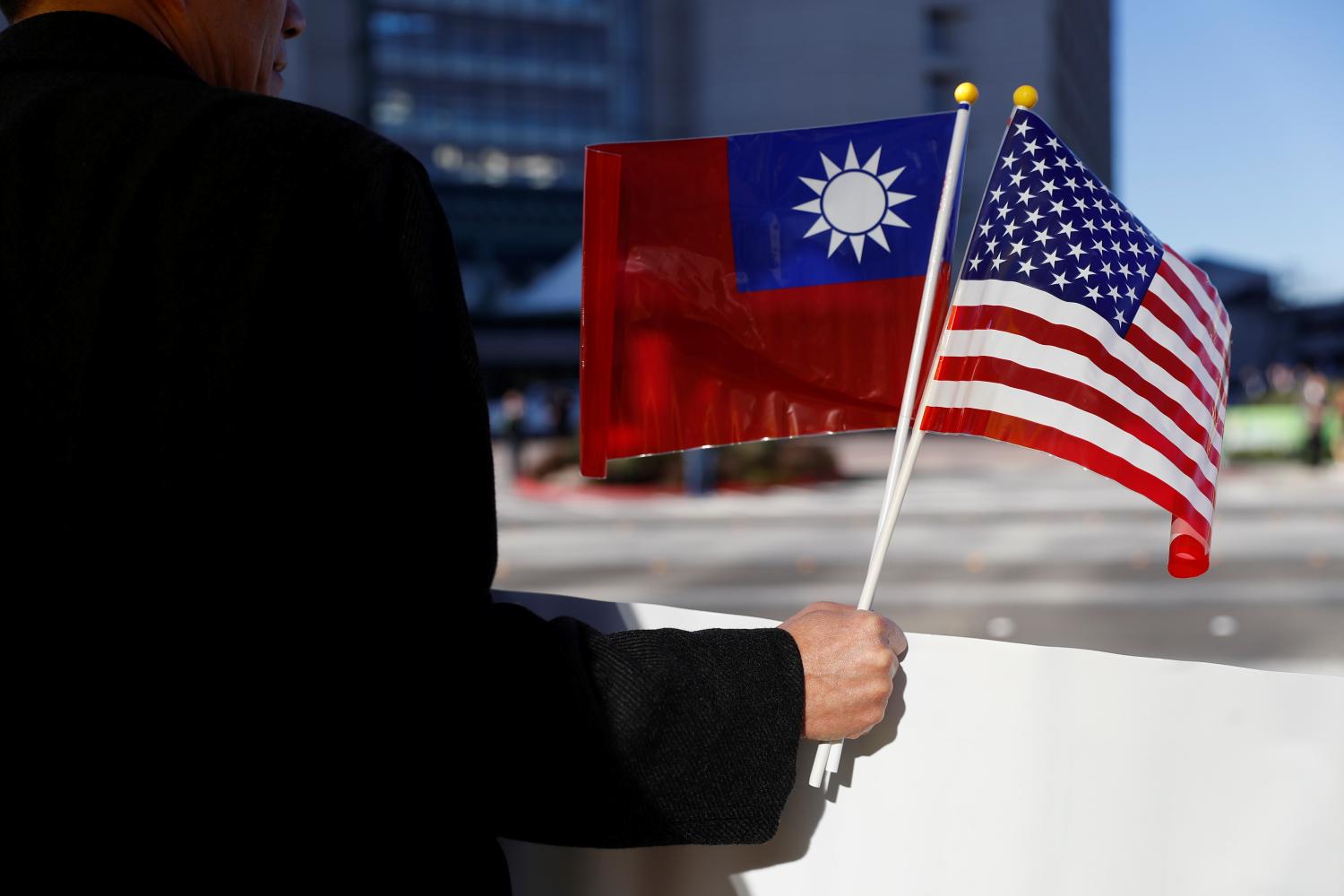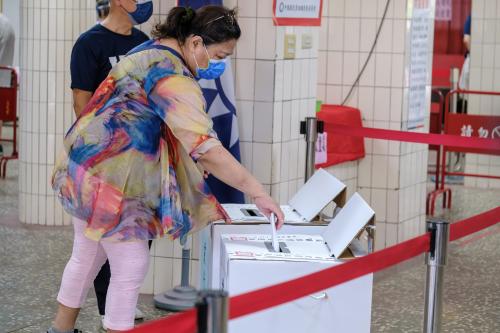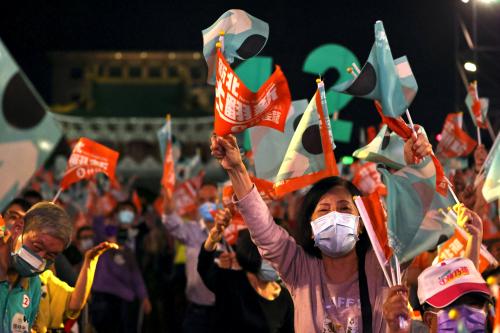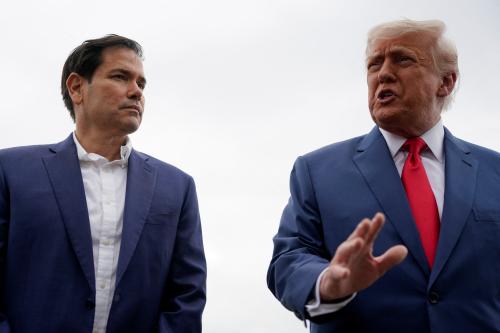In the run-up to Taiwan’s 2024 presidential election, the Brookings Center for East Asia Policy Studies solicited contributions from two leading voices from a rising generation of thought leaders from different perspectives to assess the role of the United States in cross-Strait relations. The authors, who belong to the Kuomintang and the Democratic Progressive Party respectively, were asked to offer their own independent analysis, and do not speak on behalf of the political party that they support. The goal of this piece and its companion is to highlight some of the policy differences and similarities among Taiwan’s major political parties, in order to contribute to elevating public understanding of the issues at play in Taiwan’s upcoming election. This piece is part of the Taiwan-U.S. Quarterly Analysis series, which features the original writings of experts with the goal of providing a range of perspectives on developments relating to Taiwan.
The recent decision by the United States to provide Taiwan with a $345 million defense package highlights the island’s need to bolster its readiness amid the intense competition between the United States and China. This move, authorized for the first time under the Presidential Drawdown Authority, signifies a significant step in strengthening Taiwan’s defense. It’s worth noting that U.S. defense assistance enjoys broad support across Taiwan’s political spectrum, including factions traditionally viewed as having a more conciliatory stance toward Beijing. This shift reflects an evolving perspective on cross-Strait relations influenced by democratic elections over the years.
The Kuomintang (KMT), once favoring reunification with China, has now progressively embraced civic nationalism, emphasizing democratic values over traditional Chinese ethnic nationalism. This transformation is driven by the recognition that most Taiwanese identify as Taiwanese, not Chinese, and the realization that maintaining friendly relations with the mainland without a strong defense against the People’s Liberation Army is viewed as problematic by Taiwanese voters.
This analysis delves into the evolving viewpoints of the KMT regarding cross-Strait relations, emphasizing the party’s need to adapt its perspective to align with public opinion as a democratic entity. It also explores the potential for creating a stable framework within the triadic dynamic involving the United States, China, and Taiwan.
The KMT and the changing Taiwanese voter
To understand the shifting dynamics of the KMT’s stance on China, one should consider two significant developments. First, the KMT’s novel embrace of civic nationalism recognizes the Republic of China’s political autonomy in Taiwan, all the while being inclusive of diverse ethnic identities and diverging from its historical leanings toward Chinese nationalism and unification. The Election Study Center of National Chengchi University reveals a sustained preference for the status quo among the Taiwanese public, which is the key motivation for the KMT’s shift. Figure 1 reveals that, as of June 2023, a significant majority of respondents — nearly 61% — favors the status quo, steering clear of a distinct tilt in favor of either reunification with mainland China or Taiwanese independence. This inclination has consistently dominated public sentiment for the past 20 years. Within this context, while specific to the KMT, explicit support for unification has been on a decline for the past 30 years. These evolving dynamics and public sentiment have influenced the KMT’s move.
Second is the KMT’s emphasis on defense, another dimension to consider in perceptions of the cross-Strait relationship. The prevalent view across Taiwan, as indicated by the Taiwan National Security Survey (TNSS), is a perception that cross-Strait tensions have escalated. The TNSS conducted most recently by Duke University in December 2022 presents the perceived state of relations between mainland China and Taiwan, using a scale of 0 to 10, where 0 denoted strong hostility and 10 signified harmonious relations. Most respondents across party affiliations rated the relationship as hostile, scoring it below 5. To determine whether this perception of hostility had grown over time, a comparison was made with the results of the same survey question carried out by TNSS in 2020. As depicted in Figure 2, there was a clear increase in perceived hostility in 2022. This growing sentiment underpins the KMT’s newfound emphasis on defense, indicated in part by the party’s broad support for the defense package announced by the United States in July 2023.
The intensifying unease about tensions coupled with increased support for the status quo highlights the Taiwanese population’s judicious approach to cross-Strait relations, aiming to preserve equilibrium in the face of mounting pressures. It is clear that in order to garner support in Taiwan’s democratic elections, the KMT must attune itself to the electorate’s voice and reevaluate its policies to maintain the status quo.
Establishing a guardrail for Cross-Strait relations
In light of Taiwan’s political transformation after the 2020 election, the KMT has been proactively searching for alternative strategies concerning cross-Strait relations. The metaphorical term “guardrail” encapsulates the KMT strategic goal of preserving Taiwan’s autonomy while concurrently minimizing the possibility of conflict or potential military engagement. At the core of this strategy is the intricate task of recognizing Taiwan’s unique identity — widely endorsed by its populace — without resorting to a bold declaration of independence, which could heighten tensions with mainland China. Achieving this balance requires a judicious blend of strategic defense posturing and effective diplomatic engagement.
In pursuit of this equilibrium, KMT Chairman Eric Chu unveiled the “2D strategy,“ denoting “defense” and “dialogue.” This strategy reflects the KMT’s rejuvenated emphasis on ensuring Taiwan’s security and fostering diplomatic discourse. While it reinforces the party’s alignment with democratic nations and U.S. interests, it also stresses the necessity of consolidating Taiwan’s relationship with Japan and working toward a harmonious coexistence with mainland China. However, certain quarters opined that the “2D strategy” inadequately prioritized defense, thus eliciting skepticism both domestically and from Washington’s policy circles regarding the KMT’s dedication to fortifying Taiwan’s defensive apparatus.
Addressing this feedback, Hou Yu-ih, the KMT’s 2024 presidential nominee, has championed an intensified defense-centric approach. Hou accentuates the “Constitutional 1992 consensus” — a philosophy earlier promulgated by former KMT Chairman Johnny Chiang. Fundamentally, Hou contends that the inherent merit of the “1992 consensus” is its acknowledgment of the Republic of China (Taiwan). By endorsing this view, he consciously differentiates from China’s “one country, two systems” proposal, emphasizing the KMT’s stance that both preserves the Republic of China’s identity and ensures Taiwan’s autonomy without inadvertently triggering potential confrontations.
Furthermore, Hou delineates a new “three Ds“ principle for directing cross-Strait dynamics, contingent upon his potential presidential tenure: “deterrence,” “dialogue,” and “de-escalation.” The emphasis on “deterrence” indicates Hou’s conviction that a formidable deterrence mechanism is a precursor for substantive dialogue with Beijing. Within this dialogic framework, the Constitutional 1992 consensus, even if not entirely consonant with Beijing’s perspective, offers a foundation for facilitating sustained bilateral interactions. Backed by a robust deterrence capability and on the basis of this shared premise, Hou’s emphasis on “de-escalation” aims to foster a conducive political ambiance for future engagements.
The KMT’s approach indicates the party’s attempt to transcend a “pro-China” label and may serve as a deterrent to cross-Strait conflict. Indeed, the KMT thinks about deterrence as requiring a confluence of strategic communications and demonstrable actions purposed to deter adverse actions and temper existing tensions. The KMT’s insistence on the Republic of China’s existence as the foundation for bilateral dialogues, underpinned by the Constitutional 1992 consensus and a strong defense apparatus, is therefore intended to uphold Taiwan’s autonomy while advocating harmonious reactions with mainland China.
What’s next for the U.S.
The KMT’s recent adoption of a more hawkish orientation toward cross-Strait relations illustrates the party’s strategic evolution. The distinction between the constitutional “1992 consensus” and Beijing’s “one country, two systems” proposition further underlines the intricacies of this shift. Notably, Beijing, while demonstrably anchored in the “1992 consensus,” could exhibit flexibility in seeking a new consensus. The KMT’s strategic gamble is predicated on Beijing’s discernible reluctance to use military force in reclaiming Taiwan in the near term. The continuing status quo in Taiwan remains a more preferable alternative for Beijing than an aggressive pursuit of Taiwanese independence.
Amid escalating tensions in the Taiwan Strait, concerns in Washington center on suspicions about Taiwanese political elites’ dedication to preserving democratic values. This could potentially undermine efforts to deter Chinese ambitions. The KMT, once seen as leaning toward Beijing, has been driven to redefine its position in order to ensure its continued political relevance. From a U.S. standpoint, recognizing that Taiwan’s polity has unified resolve to deter Chinese aggression could alleviate concerns on the island, minimizing debates about the viability of continued U.S. support.
While the unified self-defense sentiment in Taiwan helps the United States and Taiwan collaborate to counterbalance China, differences in defense capabilities and political resolve across the Taiwan Strait raise eyebrows in U.S. strategic circles. This isn’t a critique of Taiwan’s defense prowess; rather, it is a suggestion that an unwavering commitment to democratic values by Taiwan is its most formidable defense.
The Brookings Institution is committed to quality, independence, and impact.
We are supported by a diverse array of funders. In line with our values and policies, each Brookings publication represents the sole views of its author(s).









Commentary
From dove to hawk: KMT’s transformation and the quest for new guardrails in cross-Strait relations
October 12, 2023